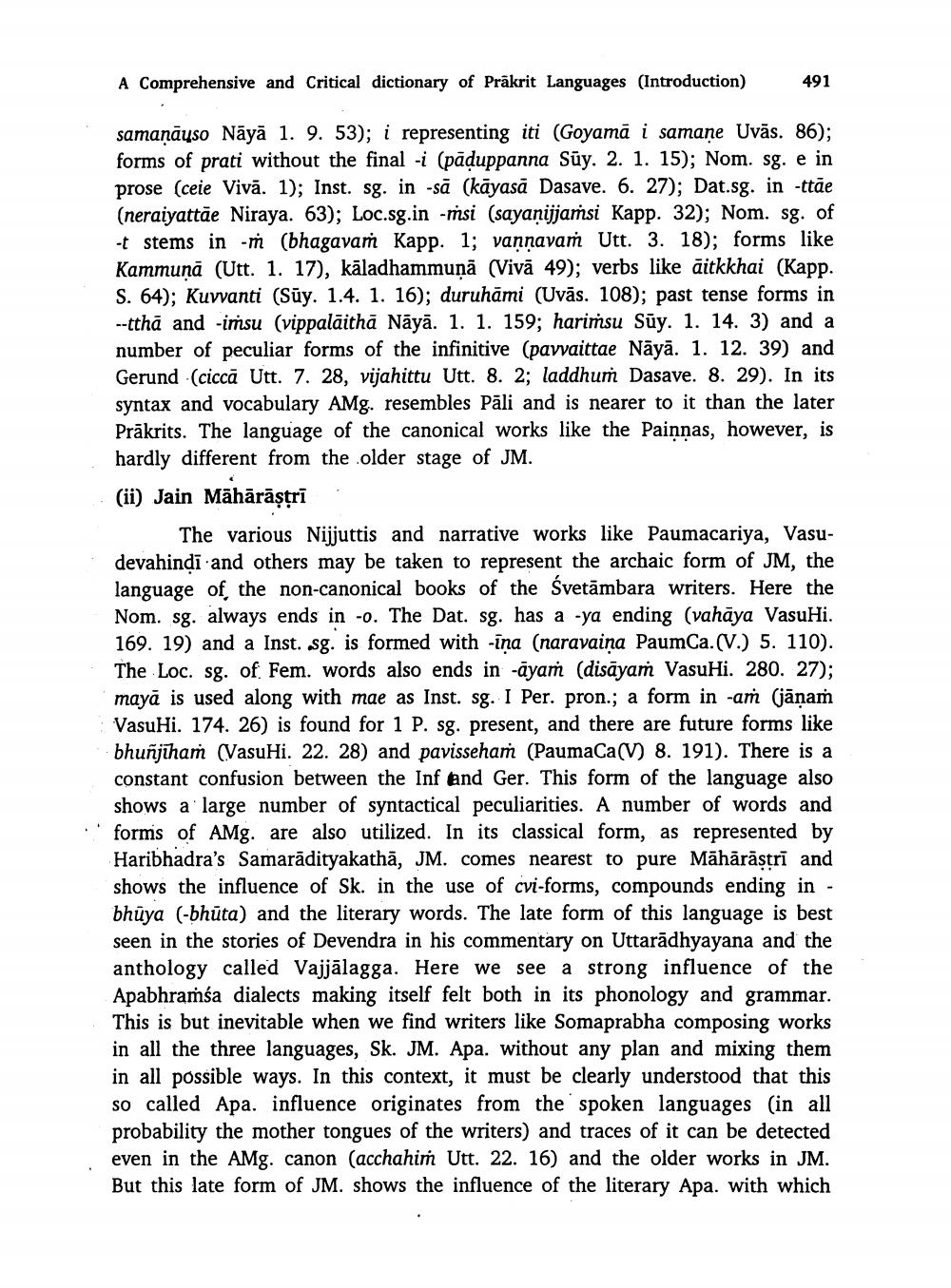________________
A Comprehensive and Critical dictionary of Prākrit Languages (Introduction)
491
samanāųso Nāyā 1. 9. 53); i representing iti (Goyamā i samane Uvās. 86); forms of prati without the final -i (pāduppanna Suy. 2. 1. 15); Nom. sg. prose (ceie Vivā. 1); Inst. sg. in -sā (kāyasă Dasave. 6. 27); Dat.sg. in -ttae (neraiyattāe Niraya. 63); Loc.sg.in -ṁsi (sayanijjamsi Kapp. 32); Nom. sg. of -t stems in - (bhagavaṁ Kapp. 1; vannavaṁ Utt. 3. 18); forms like Kammunā (Utt. 1. 17), kāladhammunā (Vivā 49); verbs like äitkkhai (Kapp. S. 64): Kuvvanti (Sūy. 1.4. 1. 16); duruhāmi (Uvās. 108); past tense forms in --tthā and -imsu (vippalaithā Nāyā. 1. 1. 159; harimsu Sūy. 1. 14. 3) and a number of peculiar forms of the infinitive (pavvaittae Nāyā. 1. 12. 39) and Gerund (cicca Utt. 7. 28, vijahittu Utt. 8. 2; laddhur Dasave. 8. 29). In its syntax and vocabulary AMg. resembles Pāli and is nearer to it than the later Prākrits. The language of the canonical works like the Paiņnas, however, is hardly different from the older stage of JM. (ii) Jain Māhārāștri "
The various Nijjuttis and narrative works like Paumacariya, Vasudevahindi and others may be taken to represent the archaic form of JM, the language of the non-canonical books of the Svetämbara writers. Here the Nom. sg. always ends in -0. The Dat. sg. has a -ya ending (vahāya VasuHi. 169. 19) and a Inst. sg. is formed with -īņa (naravaiņa PaumCa. (V.) 5. 110). The Loc. sg. of Fem. words also ends in -āyaṁ (disāyaḥ VasuHi. 280. 27); mayā is used along with mae as Inst. sg. I Per. pron.; a form in -as (jāņam VasuHi. 174. 26) is found for 1 P. sg. present, and there are future forms like bhunjiham (VasuHi. 22. 28) and pavissehaṁ (PaumaCa(V) 8. 191). There is a constant confusion between the Inf and Ger. This form of the language also shows a large number of syntactical peculiarities. A number of words and forms of AMg. are also utilized. In its classical form, as represented by Haribhadra's Samarādityakathā, JM. comes nearest to pure Māhārāștri and shows the influence of Sk. in the use of cvi-forms, compounds ending in - bhūya (-bhūta) and the literary words. The late form of this language is best seen in the stories of Devendra in his commentary on Uttarādhyayana and the anthology called Vajjālagga. Here we see a strong influence of the Apabhraṁsa dialects making itself felt both in its phonology and grammar. This is but inevitable when we find writers like Somaprabha composing works in all the three languages, Sk. JM. Apa. without any plan and mixing them in all possible ways. In this context, it must be clearly understood that this so called Apa. influence originates from the spoken languages in all probability the mother tongues of the writers) and traces of it can be detected even in the AMg. canon (acchahim Utt. 22. 16) and the older works in JM. But this late form of JM. shows the influence of the literary Apa. with which




